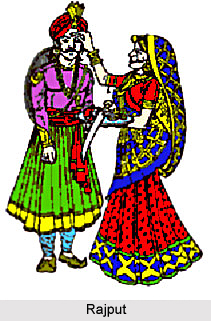 The Rajputs and the Rathores has been one of the most famous rulers of western India. Rathore is a Rajput tribe of India from the Marwar region of western Rajasthan, dwelling in the Idar state of Gujarat and also the Chhapra and Muzaffarpur districts of Bihar in very small numbers. In India, the native languages of the Rajputs and the Rathore clans are Hindi and its dialects include Rajasthani, Marwari and other languages of Rajasthan, Gujarati and Kutchi in Gujarat, as well as Punjabi in the Punjab a dialect of Punjabi called Rathi spoken in Ratia and Tohana in present day Haryana.
The Rajputs and the Rathores has been one of the most famous rulers of western India. Rathore is a Rajput tribe of India from the Marwar region of western Rajasthan, dwelling in the Idar state of Gujarat and also the Chhapra and Muzaffarpur districts of Bihar in very small numbers. In India, the native languages of the Rajputs and the Rathore clans are Hindi and its dialects include Rajasthani, Marwari and other languages of Rajasthan, Gujarati and Kutchi in Gujarat, as well as Punjabi in the Punjab a dialect of Punjabi called Rathi spoken in Ratia and Tohana in present day Haryana.
Rajputs and the Rathores are the people from the west Rajasthan and the Rathore`s particularly have many gotras, most of these gotras are from the name of the great warriors of the past and their family members are still using those gotras. Rathore`s are known to be the worshipers of sun. The huge group of Rathore`s occupies Jodhpur in present districts including Pali, Ajmer, Nagaur, Barmer, Sirohi. The Rathores of Bikaner lived in districts like Bikaner, Churu, Ganganagar and Hanumangarh.
The Rajputs - Rathores dynasties ruled a number of kingdoms and significant states in Rajasthan and neighboring states before India`s independence in 1947. The largest and oldest districts among these were Jodhpur, in Marwar and Bikaner and the Idar State in Gujarat. The Maharaja of Jodhpur is thought to be the head of the extended Rathore clan of Hindu Rajputs.
The "khyats" or the traditional accounts, written in seventeenth century, the history of the Rathores is narrated. They say that this clan was originally feudatories of the Ujjaini-based Gurjara-Pratihara dynasty, and may perhaps have been domiciled in the locality of Kannauj in the good days of that dynasty. Pratihara-ruled Kannauj was sacked by Mahmud of Ghazni in 1019 CE, which brought about a chaotic period for that area. The "Gahadvala" dynasty gained control of Kannauj and controlled for nearly a century; their best-known dynast was Raja Jaichand, who was also their last king.
Kannauj displaced the Gahadvalas by the invasion, in 1194 CE, of Muhammad of Ghor. It is said that Sheoji, a surviving grandson of Jaichand, made his way into the western desert with a large group of faithful supporters, finally settling in the town of Pali in Marwar, which was supervised by another branch of the Pratiharas. Sheoji is regarded as the patriarch of the entire Rathore clan. The custom finds supports from a number of inscriptions found in the vicinity of Kanauj. These inscriptions mention several generations of a Rashtrakuta dynasty that was ruling there for two centuries. A very similar account is also mentioned in the "Rashtrayudha Kavya" of Rudrakavi and was finished in 1595. Rudrakavi was the court poet in the court of the Rathore king, Narayana of Mayurgiri. The Rathores gradually started to live all across Marwar, thus forming a brotherhood of landowners and village chieftains. Ties of clan and caste loosely bound the population to each other. Rao Jodha, a warrior who founded a kingdom that grew to encompass all of Marwar, thus marked an era in the history both of Marwar and of the Rathores.
 Rao Jodha also founded the city of Jodhpur in 1459 and moved his capital to Marwar from Mandore. One of his sons, Rao Bika, with the help of his brave uncle Rawat Kandhal founded the town of Bikaner in 1488. Some of these migrations from Marwar into Gujarat caused great alterations in language and the spelling of Rathore to Rathod, which is seen in clans present in Gujarat. Rathods of Gujarat outline their history to the city Jodhpur. The various cadet branches of the Rathore clan progressively spread to cover all of Marwar and later went out abroad to found states in Central India and Gujarat.
Rao Jodha also founded the city of Jodhpur in 1459 and moved his capital to Marwar from Mandore. One of his sons, Rao Bika, with the help of his brave uncle Rawat Kandhal founded the town of Bikaner in 1488. Some of these migrations from Marwar into Gujarat caused great alterations in language and the spelling of Rathore to Rathod, which is seen in clans present in Gujarat. Rathods of Gujarat outline their history to the city Jodhpur. The various cadet branches of the Rathore clan progressively spread to cover all of Marwar and later went out abroad to found states in Central India and Gujarat.
At the time of India`s independence in 1947, the princely states ruled by various branches of the Rathore dynasty like -
• Jodhpur (Marwar) with districts of Jodhpur, Pali, Nagaur, Barmer, and Jalor
• Sitamau in present-day Mandsaur District of Madhya Pradesh, founded 1701 by Raja Kesho Das
• Bikaner (Jangladesh) with districts of Bikaner, Churu, Ganganagar and Hanumangarh
• Idar in present-day Gujarat, founded in 1728 or 1729
• Kishangarh in present-day Rajasthan, founded in 1611 by Raja Kishan Singh, son of Udai Singh of Marwar
• Sailana in Ratlam District of Madhya Pradesh, established in 1730 by Raja Jai Singh
• Ratlam in present-day Ratlam District of Madhya Pradesh, founded 1651
In modern times, the Rathores living in Punjab region of India, in Ropar district near Chandigarh, also have 28 villages in northern Punjab, Lahor and Amritsar. The Rathores in Madhya Pradesh, dwell in the districts of Rewa, Sehore, Jabalpur, Indore, Bhopal, Betul and Gwalior and in Uttar Pradesh, they live in Dahia, Manda, and Vijaypur. The Rathores living in Bikaner occupy districts including Bika Rangot, Sidhmudh, Banirot, Kandhal.
The Jodha are the Rathores of Jodhpur and the Jaitawat are the descendent of Rao Jaitaji Rathore, living around Pali. The Balawat, Jagirs, Champawat, Udawat are other dwelling places of the Rathores. The Rajputs and Rathores are best known for their courage and bravery over the decades. The battles in western India and triumphs over the regions prove their undisputed courage and leadership quality. The status of Rajputs and Rathores are still at high regard and they are considered as belonging to one of the most idealist and generous community of the society.






